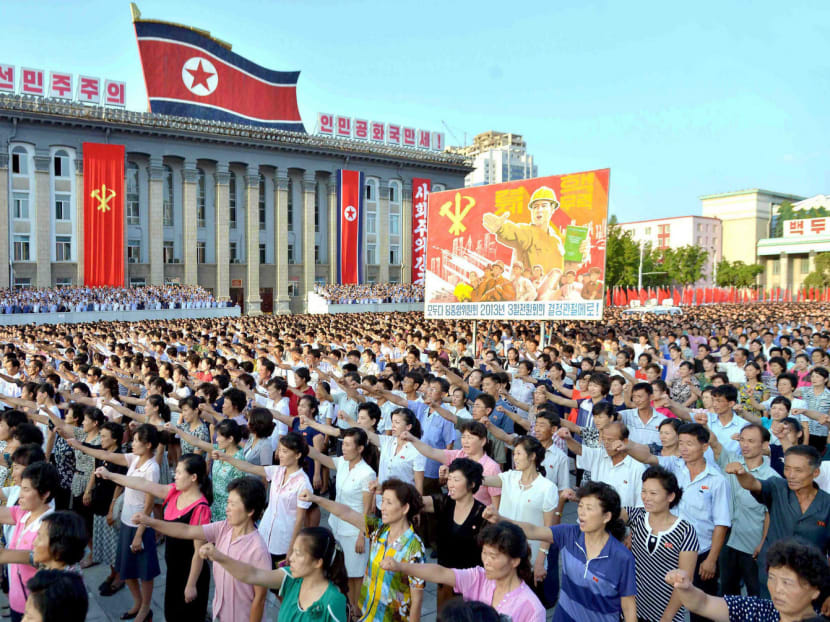North Korea plans to fire missiles near Guam ‘in days’
SEOUL — North Korea said yesterday that it was drawing up plans to launch four intermediate-range ballistic missiles (IRBMs) into waters near Guam in the Western Pacific to teach United States President Donald Trump a lesson.

A mass rally being held at Kim Il Sung Square in Pyongyang on Wednesday to support the statement of the Democratic People’s Republic of Korea government. Photo: Reuters
SEOUL — North Korea said yesterday that it was drawing up plans to launch four intermediate-range ballistic missiles (IRBMs) into waters near Guam in the Western Pacific to teach United States President Donald Trump a lesson.
This drew a robust response from allies South Korea and Japan, which said it had the legal right to shoot them down. If the North were to follow through on its threat to launch an “enveloping strike” in the vicinity of Guam, it would be the first time that a North Korean missile landed so close to a US territory.
The North’s official Korean Central News Agency (KCNA) reported that, according to the plan, four of the country’s Hwasong-12 IRBMs would fly over the three southern Japanese prefectures of Shimane, Hiroshima and Kochi, before falling into the ocean about 30km to 40km from the coast of Guam.
In addition to serving as a warning to the US, the proposed missile launches would also be a bold challenge to Japan. Some of the North Korean missiles launched in recent months have fallen in waters near Japan, but none of them have actually flown over the country. Pyongyang has said that it launched its previous test missiles at highly lofted angles so that they would not fly over Japan.
North Korea will fine-tune its launching plans by the middle of this month and wait for a final order from leader Kim Jong-un, KCNA said, citing General Kim Rak-gyom, commander of the Strategic Force of the Korean People’s Army.
The general’s remarks came a day after Mr Trump warned that North Korea would be met with “fire and fury, and frankly power the likes of which the world has never seen before” if it continued to expand its nuclear and missile programmes. The North also test-fired two intercontinental ballistic missiles last month, demonstrating an ability to launch a missile that potentially could hit the continental US with a nuclear payload.
“Sound dialogue” is not possible with someone “bereft of reason, and only absolute force can work on him”, Gen Kim said, accusing Mr Trump of having spoken “a load of nonsense”.
He also said that Mr Trump, who he said was spending his time on the “golf links”, was failing to “grasp the ongoing grave situation”.
The war of words between Washington and Pyongyang has unnerved regional powers and global investors. Global stocks fell for a third day yesterday, with shares in Seoul slumping to a seven-week low.
Visitors and residents on Guam appeared to be taking things in their stride. The main beach front on the island was packed with tourists.
In response to the North Korean announcement, South Korea and Japan warned yesterday of strong action should Pyongyang carry through with the threat.
A spokesman at South Korea’s Joint Chiefs of Staff said: “We give a strict warning. “If North Korea commits provocations despite our stern warning, it will face a strong response from South Korea’s military and the US-South Korea alliance.”
Later in the day, South Korea’s National Security Council took a softer tone, saying the door for dialogue remained open, and it would take all possible steps to ease tensions.
Taking it a step further, Japan’s Defence Minister Itsunori Onodera told Parliament that a missile attack on Guam would be a Japanese national emergency because it would threaten Japan’s existence as a nation.
However, it is unclear if Japan could shoot down a missile heading to Guam, according to Mr Lance Gatling, president of Nexial Research, an aerospace consultancy in Tokyo.
“My initial impression would be not really,” Mr Gatling said. “A ballistic missile going to Guam is flying very high, going very fast and accelerating by the time it’s over Japan. Without prior knowledge that it’s coming, you are reduced to chasing it, which is a great disadvantage.”
Experts added that the plans unveiled by the reclusive North ratcheted up risks significantly, since Washington was likely to view any missile aimed at its territory as a provocation.
“Even if the North’s missiles do not hit the ocean territory of Guam, the US will not tolerate such a provocation simply because it is a severe threat to its national security,” said Mr Cha Do-hyeogn, visiting researcher at the Asian Institute for Policy Studies in Seoul. Mr Lee Choon-geun, senior research fellow at South Korea’s state-run Science and Technology Policy Institute, said there was a risk that any missile could land much closer to Guam than planned.
“The United States will consider it an apparent attack if it lands within its territorial waters and, given the risks involved, will most likely try to shoot them down before they land anywhere close to Guam and its territorial sea,” he told Reuters.
“This could elevate the threats to an unprecedented level.” AGENCIES






